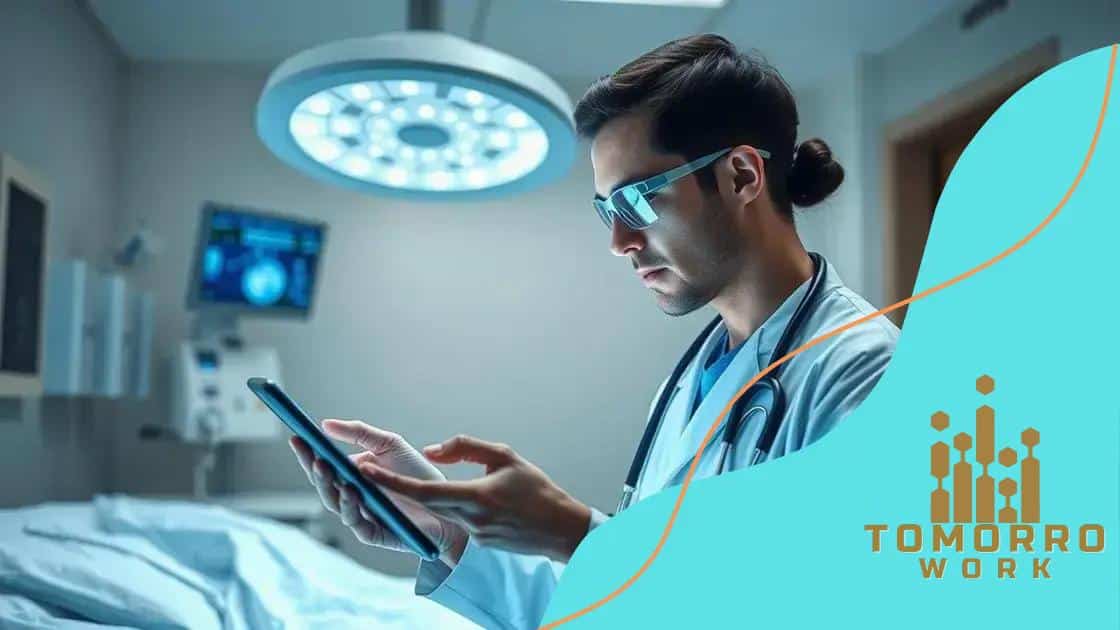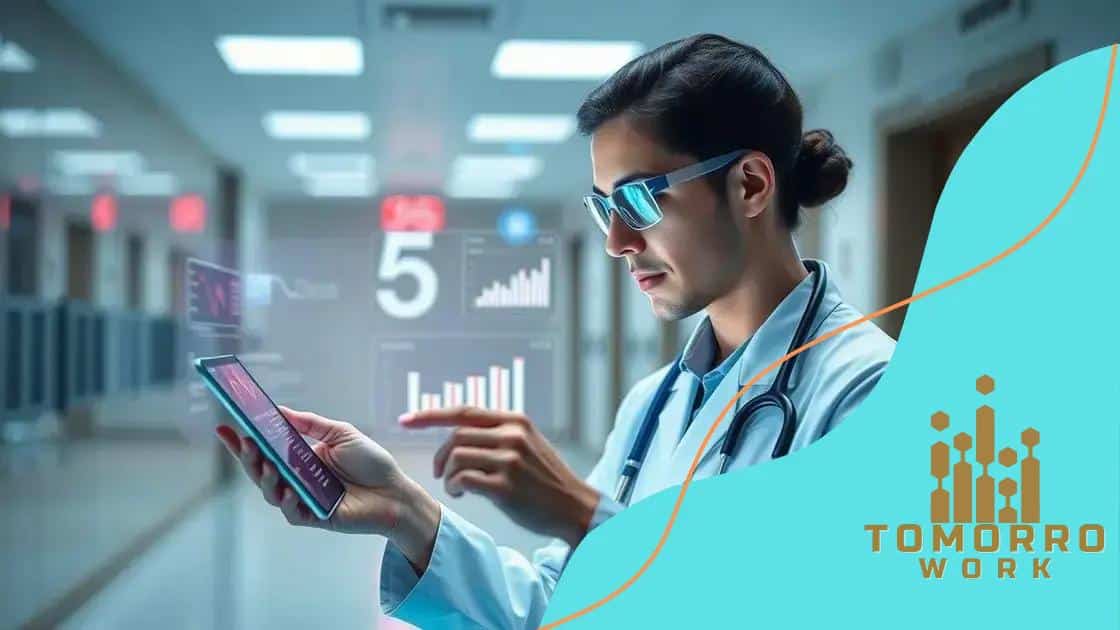How 5G is enhancing the healthcare industry

Advertisements
5G is enhancing the healthcare industry by improving telemedicine, enabling real-time patient monitoring, facilitating remote surgeries, and addressing security challenges through robust data protection measures.
How 5G is enhancing the healthcare industry brings advanced technology to the forefront of patient care. You might wonder how faster connections will impact hospitals and clinics. Let’s dive into the exciting ways 5G is transforming healthcare.
Advertisements
The role of 5G in telemedicine
The role of 5G in telemedicine is transforming how patients and doctors interact. With this advanced technology, healthcare can become more accessible and efficient. In telemedicine, doctors can connect with patients in remote areas. This is especially beneficial for those who have trouble traveling due to distance or health concerns.
Benefits of 5G in Telemedicine
The advantages of using 5G in telemedicine include:
- Faster data transmission, enabling real-time video consultations
- Improved connectivity, reducing lag and enhancing patient experience
- Greater data capacity, allowing for high-quality imaging and streaming
- Enhanced security, ensuring patient information remains confidential
With 5G, doctors can remotely monitor patient vitals more accurately. They can receive instant alerts for critical changes in a patient’s condition. This quick response can make a difference in emergencies.
Advertisements
Why Remote Consultations Matter
Remote consultations are not just a convenience; they are vital. Many patients with chronic conditions benefit from regular check-ins that can happen over a video call. This means they can avoid unnecessary trips to the clinic, saving time and reducing exposure to illnesses.
Moreover, 5G supports the use of advanced technologies like artificial intelligence during consultations. AI can help analyze patient symptoms in real-time, providing doctors with insights that improve diagnosis and treatment.
As telemedicine grows, the role of 5G will only become more significant. It ensures that patients receive quality care from anywhere, breaking down barriers to health access. The future of healthcare is bright with these innovations, allowing everyone to connect and receive the care they need.
Improving patient monitoring with 5G
Improving patient monitoring with 5G technology is revolutionizing how healthcare providers track vital signs and health conditions. This enhancement enables real-time data transmission, which is crucial for timely interventions.
Advantages of 5G in Patient Monitoring
With 5G, healthcare professionals can monitor patients more effectively from a distance. The benefits include:
- Instantaneous data sharing between devices and providers
- Improved accuracy in monitoring vital signs
- Real-time alerts for significant changes in health
- Enhanced patient engagement through accessible data
This technology doesn’t just mean faster connections; it enhances patient care. For instance, devices connected via 5G can send alerts directly to medical staff if a patient’s heart rate exceeds normal levels. This leads to quicker responses, which can be vital in emergency situations.
Utilization of Wearable Devices
Wearable devices, such as smartwatches or health monitors, play a significant role in improving patient monitoring. These devices collect important health data and transmit it over 5G networks. The capacity for constant monitoring results in better health outcomes.
Moreover, healthcare providers can analyze this data using advanced software tools. They can identify trends and potential issues before they escalate. This means a proactive approach to patient care, as opposed to reactive treatments.
As technology evolves, the use of 5G in patient monitoring will continue to grow, making healthcare more efficient and responsive. Patients can rest assured knowing that their health is being monitored closely, allowing for greater peace of mind.
5G and data management in healthcare

5G and data management in healthcare is reshaping how medical information is handled. With the increase in data generation from various devices, effective management becomes crucial. 5G technology enables faster processing and transmission of this vast amount of data.
Key Benefits of 5G for Data Management
Utilizing 5G improves healthcare systems significantly. The key benefits include:
- Rapid data transmission, reducing delays in information access
- Increased storage capabilities for patient records
- Enhanced analytics, leading to better patient outcomes
- Improved data security through advanced encryption methods
These improvements allow healthcare providers to quickly access patient records, which is vital during emergencies. For example, when a patient arrives at a hospital, doctors can instantly retrieve medical history and make informed decisions.
Streamlining Processes with 5G
5G also helps streamline various processes in healthcare settings. Health information systems can communicate seamlessly, making it easier to manage appointments and patient flow. The exchange of information between devices, such as monitors and medical software, is much quicker.
As hospitals and clinics integrate 5G into their operations, they can enhance their efficiency. Data-driven decisions can lead to personalized treatment plans for patients. Moreover, the ability to manage data in real-time improves the overall quality of care.
With the rise of telemedicine and remote patient monitoring, the role of 5G in data management continues to grow. Its influence will create a more connected healthcare system, ensuring that patients get the best possible care.
Enhancing remote surgery capabilities
Enhancing remote surgery capabilities through 5G technology is groundbreaking for the medical field. This innovation allows surgeons to perform operations on patients who may be hundreds or thousands of miles away. With low latency and high-speed connectivity, surgeons can control robotic arms and surgical instruments in real-time.
Benefits of 5G in Remote Surgery
The advantages of utilizing 5G for remote surgery include:
- Immediate feedback and high-definition video feeds during procedures
- Increased precision in remote operations due to reduced delays
- Lower risk of complications as surgeons can be more responsive
- Access to specialist surgeons for patients in rural or underserved areas
This technology also supports collaboration among surgical teams. Multiple medical professionals can join a procedure, offering expertise from different locations. Surgeons can consult with their colleagues in real-time, enhancing the quality of care and decision-making.
Challenges and Considerations
Although the benefits are clear, there are challenges to consider. Reliable internet connectivity and data security are paramount in remote surgery scenarios. Healthcare facilities must ensure their networks can support 5G to minimize risks of disruptions during surgeries.
Training for medical staff on using these technologies effectively is also essential. As healthcare continues to evolve with 5G, embracing these changes will lead to better patient outcomes and more innovative surgical techniques.
Security challenges and solutions for 5G in healthcare
Security challenges and solutions for 5G in healthcare are critical topics as this technology becomes mainstream. As healthcare organizations adopt 5G, they must also address potential security risks that come with it. Protecting patient data and ensuring privacy is paramount.
Common Security Challenges
Some of the major security challenges include:
- Increased vulnerability to cyberattacks due to more connected devices
- Data breaches that could expose sensitive patient information
- Compliance with regulations like HIPAA in a digital environment
- Maintaining the integrity of medical devices connected via 5G
As the number of connected medical devices grows, so does the potential attack surface for hackers. These devices often hold important patient data, making them prime targets. Therefore, securing these devices and the data they transmit is crucial.
Solutions to Enhance Security
To effectively mitigate these risks, healthcare organizations can implement several solutions:
- Utilizing robust encryption methods for data transmission
- Regularly updating software and firmware on medical devices
- Employing advanced threat detection systems that monitor for unusual activities
- Providing staff training on security best practices and awareness
Implementing these strategies will help safeguard patient data and enhance the overall security posture of healthcare organizations. Additionally, working with cybersecurity experts can provide tailored solutions specific to each organization’s needs.
By proactively addressing these challenges, healthcare providers can fully harness the benefits of 5G technology while ensuring patient safety and data integrity.
5G technology is significantly enhancing the healthcare industry by improving telemedicine, patient monitoring, and remote surgery capabilities. As we embrace these advancements, it is essential to address the associated security challenges. By implementing robust security measures, healthcare providers can protect patient data while leveraging the benefits of 5G. The future of healthcare is bright, with the potential for better patient outcomes and more efficient services using 5G technology.
FAQ – Frequently Asked Questions about 5G in Healthcare
How does 5G improve telemedicine services?
5G enhances telemedicine by providing faster and more reliable connections, enabling real-time consultations and better patient engagement.
What are the benefits of using 5G for patient monitoring?
With 5G, healthcare providers can access patient data instantly, allowing for real-time monitoring and quicker response times in critical situations.
What security challenges does 5G face in healthcare?
5G presents risks such as increased exposure to cyberattacks and data breaches, requiring robust encryption and continuous monitoring to protect sensitive information.
How can remote surgeries be performed securely using 5G?
Remote surgeries can be performed securely by utilizing encrypted connections, real-time data feedback, and monitoring systems to ensure precision and data integrity during procedures.





